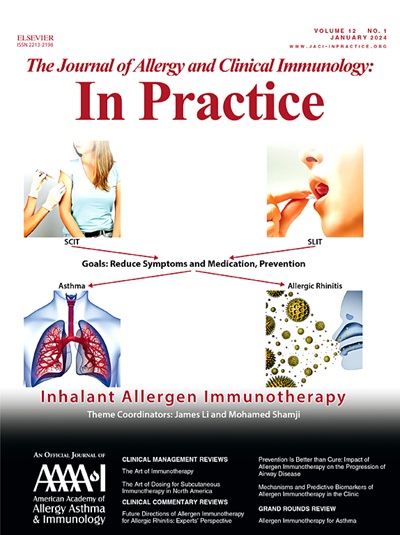Diagnostic Utility of Biomarkers in Anaphylaxis: A Systematic Review and Meta-Analysis
IF 8.2
1区 医学
Q1 ALLERGY
Journal of Allergy and Clinical Immunology-In Practice
Pub Date : 2025-06-01
DOI:10.1016/j.jaip.2025.04.008
引用次数: 0
Abstract
Background
Anaphylaxis is a life-threatening allergic reaction commonly triggered by food, venom, or drugs. Clinical criteria are central to diagnosing anaphylaxis. However, laboratory biomarkers could provide valuable confirmation when clinical diagnosis is challenging.
Objective
We aimed to evaluate key biomarkers including tryptase, histamine, platelet-activating factor (PAF), PAF-acetylhydrolase (PAF-AH), and urinary prostaglandin D2 (PGD2) for their diagnostic utility in anaphylaxis.
Methods
A systematic review was conducted following PRISMA-DTA (Preferred Reporting Items for a Systematic Review and Meta-analysis of Diagnostic Test Accuracy studies) guidelines. Studies published between 2004 and 2024 from Embase and MEDLINE were included if they evaluated the diagnostic test accuracy of tryptase, histamine, PAF, PAF-AH, or urinary PGD2 in confirmed anaphylaxis cases. Pooled sensitivity and specificity estimates were calculated using the diagmeta package in R.
Results
Twenty-eight studies with 18,749 patients were included, of whom 3329 had anaphylaxis. Tryptase was the most frequently studied biomarker (24 studies), with a pooled sensitivity and specificity of 0.49 and 0.82, respectively. Histamine had a pooled sensitivity of 0.76 and a specificity of 0.69. Limited data were available for PAF, PAF-AH, and urinary PGD2.
Conclusions
Studies suggest that tryptase remains the most widely used and accessible biomarker for diagnosing anaphylaxis mainly using the “Rule of Twos” diagnosis strategy. Histamine and urinary PGD2 show potential, though their application is limited by practical challenges. Further research is needed to establish the diagnostic roles of PAF and PAF-AH, particularly in non–IgE-mediated anaphylaxis pathways.
生物标志物在过敏反应诊断中的应用:系统回顾和荟萃分析。
背景:过敏反应是一种危及生命的过敏反应,通常由食物、毒液或药物引起。临床标准是诊断过敏反应的核心。然而,当临床诊断具有挑战性时,实验室生物标志物可以提供有价值的确认。目的:我们旨在评估包括胰蛋白酶、组胺、血小板活化因子(PAF)、PAF-乙酰水解酶(PAF- ah)和尿前列腺素D2 (PGD2)在内的关键生物标志物在过敏反应中的诊断价值。方法:根据PRISMA-DTA指南进行系统评价。Embase和MedLine在2004年至2024年间发表的研究,如果评估了胰蛋白酶、组胺、PAF、PAF- ah或尿PGD2在确诊的过敏反应病例中的诊断测试准确性,则纳入其中。结果:纳入28项研究,共18,749例患者,其中3,329例发生过敏反应。胰蛋白酶是最常被研究的生物标志物(24项研究),其敏感性和特异性分别为0.49和0.82。组胺的敏感性为0.76,特异性为0.69。PAF、PAF- ah和尿PGD2的数据有限。结论:研究表明,胰蛋白酶仍然是诊断过敏反应最广泛使用和最容易获得的生物标志物,主要使用“二规则”诊断策略。组胺和尿PGD2显示出潜力,尽管它们的应用受到实际挑战的限制。需要进一步的研究来确定PAF和PAF- ah的诊断作用,特别是在非ige介导的过敏反应途径中。
本文章由计算机程序翻译,如有差异,请以英文原文为准。
求助全文
约1分钟内获得全文
求助全文
来源期刊

Journal of Allergy and Clinical Immunology-In Practice
ALLERGYIMMUNOLOGY-IMMUNOLOGY
CiteScore
11.10
自引率
9.60%
发文量
683
审稿时长
50 days
期刊介绍:
JACI: In Practice is an official publication of the American Academy of Allergy, Asthma & Immunology (AAAAI). It is a companion title to The Journal of Allergy and Clinical Immunology, and it aims to provide timely clinical papers, case reports, and management recommendations to clinical allergists and other physicians dealing with allergic and immunologic diseases in their practice. The mission of JACI: In Practice is to offer valid and impactful information that supports evidence-based clinical decisions in the diagnosis and management of asthma, allergies, immunologic conditions, and related diseases.
This journal publishes articles on various conditions treated by allergist-immunologists, including food allergy, respiratory disorders (such as asthma, rhinitis, nasal polyps, sinusitis, cough, ABPA, and hypersensitivity pneumonitis), drug allergy, insect sting allergy, anaphylaxis, dermatologic disorders (such as atopic dermatitis, contact dermatitis, urticaria, angioedema, and HAE), immunodeficiency, autoinflammatory syndromes, eosinophilic disorders, and mast cell disorders.
The focus of the journal is on providing cutting-edge clinical information that practitioners can use in their everyday practice or to acquire new knowledge and skills for the benefit of their patients. However, mechanistic or translational studies without immediate or near future clinical relevance, as well as animal studies, are not within the scope of the journal.
 求助内容:
求助内容: 应助结果提醒方式:
应助结果提醒方式:


